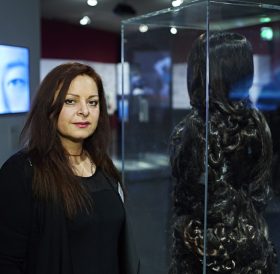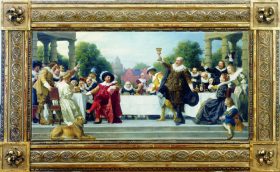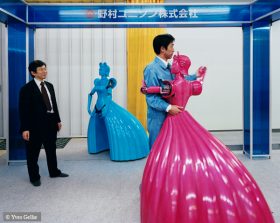Of Persian fairy tales and female self-determination

Artist Mandana Moghaddam standing next to her sculpture Chelgis I in the exhibition Cherchez la femme. Wig, Burqa, Wimple; Jewish Museum Berlin, photo: Yves Sucksdorff
In the course of the new exhibition Cherchez la femme – which deals with the covering of women within the idea of the monotheism of the three leading religions – we spoke with Iranian artist Mandana Moghaddam. Her artwork Chelgis (pronounced “Gelgis”) contributes to the concept of the exhibition in an impressive way and further stimulates the viewers’ own contemplation on the subject. Just in time for the exhibition’s opening we conducted a short interview with Mandana Moghaddam:
Dear Ms. Moghaddam, would you tell us a little bit about your artwork and the story of Chelgis?
I began my work by thinking of contemporary womens’ issues, examining them from different angles. When I drew the first sketch I saw the story of Chelgis – which means “40 braids” – right in front of me. → continue reading
– The Story of a Search

This oil sketch entitled Das Gastmahl der Familie Mosse (The Mosse Family Banquet) was restituted to the community of heirs of Felicia Lachmann-Mosse; Photo: Jewish Museum Berlin, Jens Ziehe.
Today is the International Holocaust Remembrance Day when we also remember the consequences of the criminal Nazi regime, which can still be felt today. One of these consequences is that a lot of museums are still holding cultural artifacts that were unlawfully confiscated from their owners during the Nazi era. Thus the Jewish Museum Berlin restored the oil sketch Das Gastmahl der Familie Mosse (The Mosse Family Banquet) to the heirs of Felicia Lachmann-Mosse in December last year. How was this decision reached? Provenance research has attracted increasing attention in recent years and caused frequent rumblings in the media – but how is it actually carried out? → continue reading
The golem, a character from Jewish mythology, is currently present in an interesting exhibition at the Jewish Museum Berlin. But not only there.

Yves Gellie, Human Version 2.08, Dancing Robot, Tohoku University, Japan; photo: Yves Gellie, galerie du jour agnès b
Guest article by Roberto Giardina, www.ildeutschitalia.com
In the foyer of the Museum for Communication, three robots – reminiscent of chess figures – are roaming around. They talk to the people walking up to them, stop and take a different route if you block their way, or accompany you when you walk next to them. Adults are just as fascinated as children. A visit to Berlin museums is fun, and doesn’t necessarily require you to speak German.
After playing on the ground floor at the Museum for Communication, you can visit the special exhibition on the Golden Section and have your forgotten school knowledge entertainingly refreshed (the exhibition Göttlich Golden Genial (godly golden genius) runs until 26 February, more on the Museum for Communication website (in German)).
Robots are fun to play with, but they have been the stuff of nightmares since time immemorial – will they take our jobs away from us soon? → continue reading


